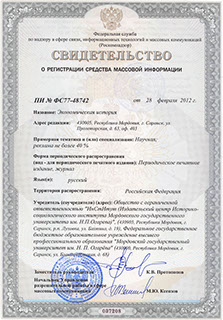Экономическая историЯ
Russian Journal of Economic History
ISSN 2409-630X (Print)
ISSN 2618-916X (Online)
Expert board:
- Scientific Council of RAS on economic history;
- Research and Educational Center «The economic history of Central Russia and the Middle Volga region» of Ogarev Mordovia State University;
- Center of Economic History of Lomonosov Moscow State University
Navigation
Certificate of registration

ISSN 2409-630X (Print), ISSN 2618-916X (Online)
DOI: 10.15507/2409-630X.052.017.202101.077-084
УДК: 355/359
Sergey G. Bandurin1, Igor B. Tsvetkov2
1 Research Institute (Military History) Military Academy of the General Staff of the Armed Forces of the Russian Federation, (Moscow, Russia),
e-mail: bs963@rambler.ru
2 Independent Researcher (Moscow, Russia),
e-mail: bs963@rambler.ru
The History of the 1947 Monetary Reform of the USSR in Moscow and Leningrad
Introduction. World and domestic economic history are the history of ups and downs, the history of finding ways out of difficult, sometimes crisis and critical situations, most often manifested both during and after wars. The Great Patriotic War, which dealt a blow to all spheres of life of the belligerent countries, was no exception. Testing the viability of the country’s economic model, in particular the Union of Soviet Socialist Republics, began directly during the war and continued after the end of hostilities. The relevance of the topic under study lies in the study of a positive example of the country’s recovery from the economic crisis, as well as the study of the reaction of the general population to the measures taken. The purpose of this article is to retrospectively analyze the economic situation of those years, to model the reader’s understanding of the reaction of society at that time to events and the way of solving the problem chosen by the party, as well as to demonstrate the results of the government’s activities. Materials and Methods. This study is based on the traditional methods used in the national historical science: problem-chronological, systemic and comparative-historical. Research Results. The analysis of the measures taken in the financial and economic sphere showed the consistency of the methods chosen by the government, however, the general assessment of the measures among the population turned out to be versatile. The assessments of the researchers of this problem, both Soviet and modern, are generally positive. Discussion and Conclusion. As a result of the monetary reform of 1947, the Soviet Union managed to avoid the depreciation of the ruble, the surplus of banknotes issued during the war years was eliminated, the state’s internal debt on bonds was significantly reduced, and the salaries of the population were preserved. This money was used to rebuild the post-war country. The abolition of cards ensured a decrease in market prices for many groups of goods and significantly reduced the number of speculators.
Keywords: monetary reform, economy, USSR, finance, denomination, ruble.
For citation: Bandurin S. G., Tsvetkov I. B. The History of the 1947 Monetary Reform of the USSR in Moscow and Leningrad. Ekonomicheskaya istoriya = Russian Journal of Economic History. 2021; 17(1): 77–84. (In Russ.). DOI: 10.15507/2409-630X.052.017.202101.077-084.
© Ogarev Mordovia State University. History and Sociology Institute, 2017
68, Of. 411, Bolshevistskaya St., 430005, The editorial office of the scholarly journal «Russian Journal of Economic History»
Tel.: (8342) 24-25-90; 27-07-11, Fax: (8342) 24-25-90, E-mail: jurnal-econom-hist@isi.mrsu.ru
Designed by A. Napalkov, Email: napalkov@isi.mrsu.ru

